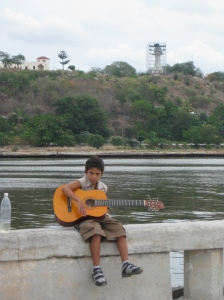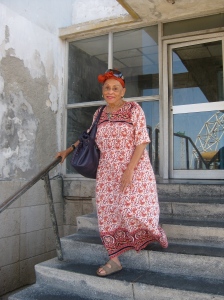Welcome to Part II of my “Wow, I’m in Cuba” series for travelers! As I mentioned previously, this 5-part series will cover:
-Mental preparation for travel abroad
-Differences between traveling alone and traveling with a group
-Language and cultural differences
-Navigating your way through a new city
-Physically adapting to a new environment
In this post, I will compare a trip I took to Cuba in June of this year with a Witness for Peace delegation to my current experiences as a single traveler, highlighting the primary differences and challenges for those considering traveling abroad solo.
If you are planning to travel abroad with a tour group, a student group, or simply as a large family vacation, you can expect less responsibility for daily activities and details. With tour groups or delegations, needs including housing, food, events, transportation and translators will likely be pre-arranged and included in your package price. Similarly, with a student group you will be among peers, housing and food will be included, and you will have access to host families and academic institutions to facilitate your language course studies. While traveling with family you have the benefit and comfort of traveling with loved ones and can share the responsibilities for planning excursions, hotel choices and meal plans. All of this changes dramatically when traveling alone.
1) Access & Planning
Traveling with a tour group eliminates the hassle of having to plan excursions, wasting precious hours of your travel days waiting in lines for tickets, and hoping you are not missing out on some other event or location that you did not know about. However, these group excursions will likely be pre-arranged and mandatory, denying you opportunities to go off exploring on your own if that is your thing. I remember resenting this in June, cursing the fact that I was stuck in group activity when I wanted to go and explore the city, see the old buildings, walk through the Plaza de Armas, see some of the beaches, talk to random strangers…anything but sitting around talking to a bunch of Americans…after all, if that was what I wanted, I would have stayed home!
However, the people and locations we had access to as a part of a group affiliated with a well-known and respected Cuban institution proved to be invaluable! We were able to meet with the Minister of Education, attend private music and dance workshops, have tours of the Museum of the Literacy Campaign and the Latin American School of Medicine, visit a daycare in Pinar del Rio, and a school for children with special needs and an elementary school in Habana. Also, since our delegation was through the Martin Luther King Center in Marianao (a neighborhood in Habana), and both our group leader and translator were Cubans, we had the benefit of learning about Cuba from Cubans.
Being here now by myself I realize how difficult it is to arrange these things on your own. I had few personal contacts in Habana before my arrival, and it has been an exhausting process making arrangements for different types of research visas, learning where different libraries and archives are, and finally finding the Jose Marti National Library only to discover that they are closed for renovations until October. Yet as frustrating and exhausting as the process continues to be as I try to integrate myself into the history/research circuit here, it has also made the process more authentic and helped me to learn how things work and what the “pace” is in Habana.
On the positive side of having to plan for yourself, it allows for spontaneity and activities to fit your personal tastes. I finally got to go to a beach (with minimal sunburn for a change), I can wander aimlessly through markets, I woke up one morning and decided to go for a walk on the Malecon and ended up in Habana Vieja, making the round trip from Vedado in about 4 hours… and I have explored the cultural life of the city, attending a concert, the theater, the National Ballet and an art exhibit. If you like planning for yourself, it can be a very rewarding experience.
2) Companionship
Having lived alone for several years in Texas and North Carolina, I did not expect to have a problem being by myself in Cuba. I fancy myself an independent woman and I have a good sense of my surroundings, so I rarely worry about my physical safety. That being said, you cannot “be an island” while living on an island. Being alone in a foreign country can be oppressively lonesome, and getting over initial social hesitations and making friends can be a challenge for some.
When traveling with a group or family, this issue is less urgent, as you have built-in companionship. Yet I urge those traveling with a group to not limit themselves to communicating only with the group. Remember, if you wanted to talk to Americans you could have stayed home, right?
As I mentioned in Part I, it is important to take advantage of the opportunity to learn about a new culture, language and society. The BEST way to learn about a country is through its people. Talk to as many people as you can…cab drivers, street vendors, people at the bus stop, your waiter, anyone!! The more people you talk to the more you will start to learn about the country.
Also, you will start to feel like less of a “foreigner” as you start to make friends. For example, as I head to school in the mornings I exit my building and wave at the man who handles the street parking outside our door. Monday through Friday before classes, I walk to the same “cafeteria” for my coffee and chat with the nice old man about my classes and the weather (post on this upcoming, as these cafeterias are not like the southern cafeterias in the US), after class I either go to the Institute of History, where I am slowly getting to know all the employees, or head home, stopping on the way at another coffee stand where I chat with another nice old Cuban man. Compare this to my first few days where I went straight to school, came straight home, worked on my research and homework and sat in my room and watched movies because I was uncomfortable wandering alone, and you can see the value of human interaction.
So to all travelers, I urge you to talk to at least 5 strangers every day (totally arbitrary number selection), and remember that the best insight into a country is the people.
3) Daily Needs
Back home, daily needs and activities such as groceries, eating out and housing needs are part of our routine…If you need groceries you go to Jewel (or HEB or Harris Teeter or Kroger depending on where my readers are logging on from). If you do not feel like cooking you can go out to Panera or Ruths Chris, depending on your budget. If you are thirsty and lucky enough to live in the Chicagoland area where our Lake Michigan water is mighty delicious, you just walk over to the faucet. If you need a new apartment or home you talk to your friends or go on rent.com or call a realtor. In the world you know and are comfortable in, all these things are relatively simple. When traveling with a group, many of these things are taken care of by the organizer, or you can be sure someone can point you in the right direction. Yet these simple needs of daily life can be a struggle while transitioning in a new country by yourself.
As with many places in the world, the idea of a massive one-stop-shop like Walmart does not exist in Cuba. I go to one place for my eggs, another for produce, another for miscellaneous, and know that some things can be at one place one day and another (or nowhere) the next. (And if you are looking for tomatoes out of season people look at you like you are insane!) I am just not starting to learn where each of these places are located, but there are no big signs for these stores in many instances so, like everything else, it has been a process.
As far as eating out, I just today had my first experience getting food at a cafeteria by myself!!! (A very proud moment for me!) As I am budgeting for a year, the restaurants are prohibitively expensive and I will likely go only on special occasions. Luckily, the streets of Habana are loaded with delicious street food from sandwiches to croquetas to pizza for incredibly cheap prices! However, you rarely see foreigners at these places by themselves, and it took me a while to get up the courage to stop at a cafeteria for lunch. (**Notice this was not the case for coffee…I could sooner live without food than coffee, and since I have not yet learned to make Cuban coffee I started stopping in to coffee places during my very first week.)
Luckily for me, housing was not an issue during my trip as I was referred to a wonderful woman with a casa particular in el Vedado by one of my professors. However, several of my classmates ended up having to stay in hotels for the first week or so—a significant expense— while searching for housing. In Cuba, licensed casa particulares are available for foreigners who prefer not to stay in a hotel. My best description of most is that they can range anywhere from a hostel-type setting to a host family to a shared or individual apartment, depending on the area and your budget. These are the best option for those on a budget or staying for an extended time, but can be difficult to research or contact from the US for reasons I will not get into. (If you are interested in researching casas in Habana, look into Conner Gorry’s APP “Havana Good Time”, which includes a list of casa particulares along with their prices, locations and contact information.)
Like everything else, you can adapt to these changes in daily life with time and patience!
****************************************************************************
Making the decision to travel alone or with a group ultimately depends entirely on your personality and comfort level. Since my trip is very lengthy, the time I have lost to “figuring things out”, waiting in line and getting helplessly lost TWICE near the capitolio is not going to take away from my overall experience. However, if you are traveling for only 1 or 2 weeks I recommend a group or some form of travel agency to help you with your planning so you can make the most of every day.





